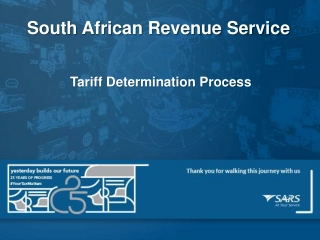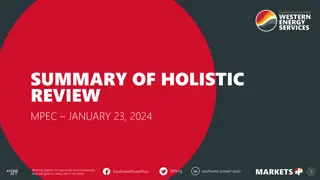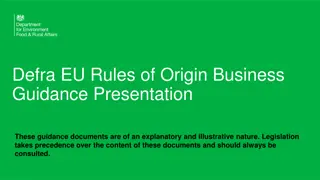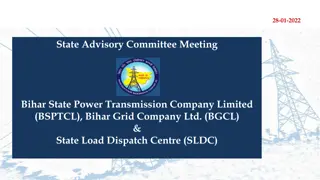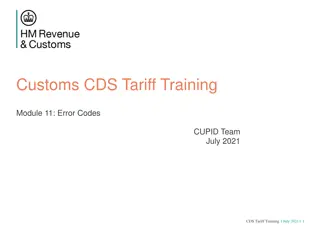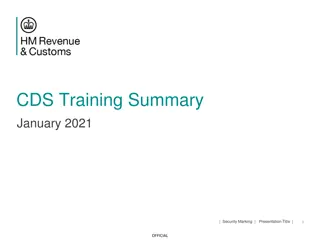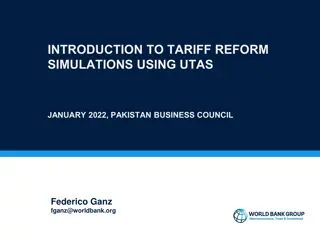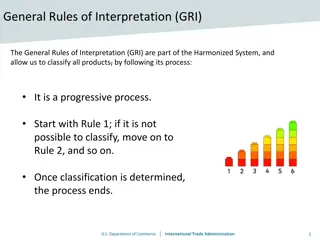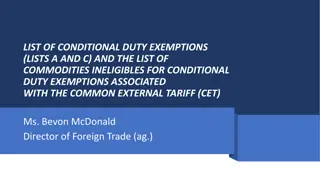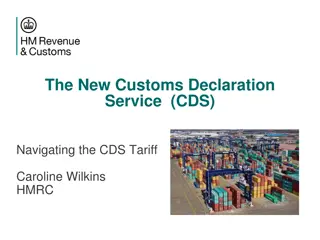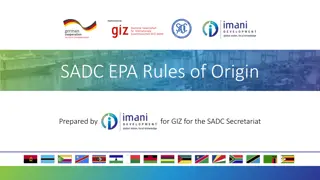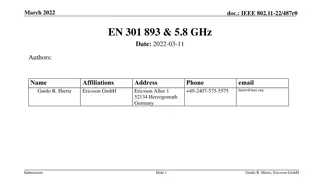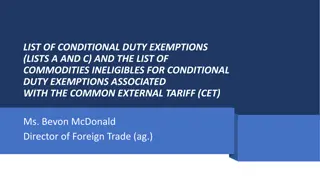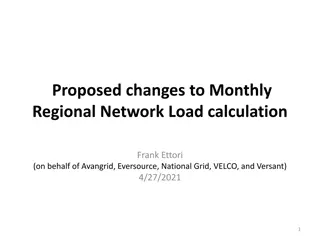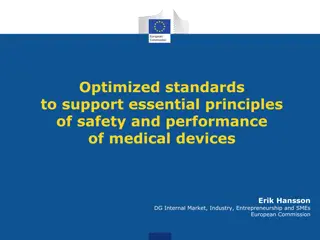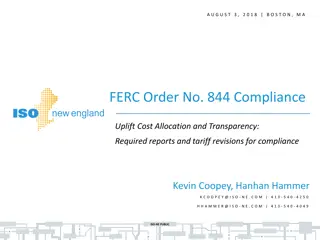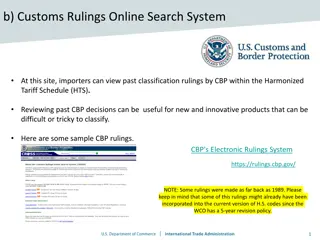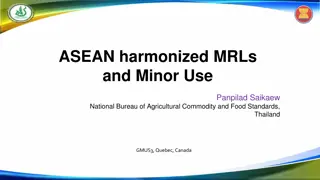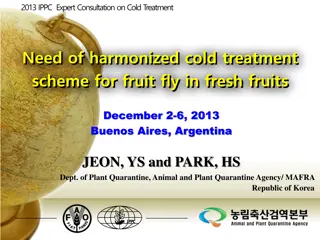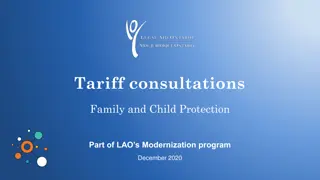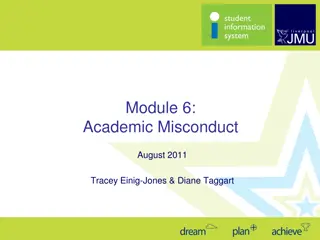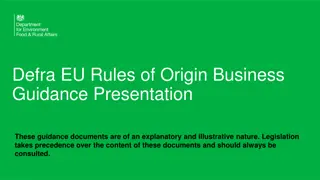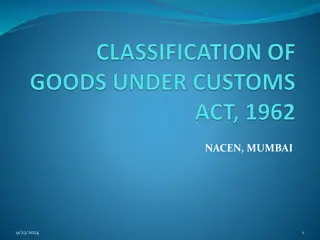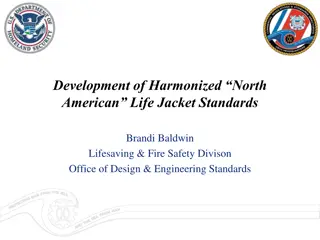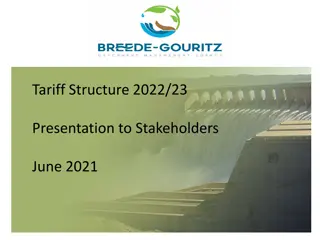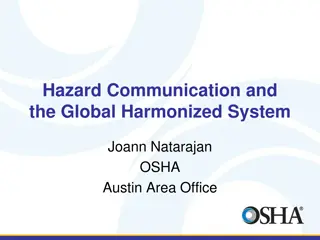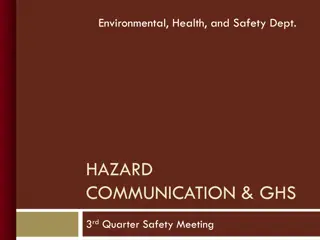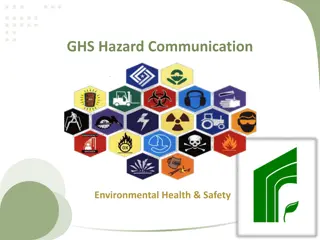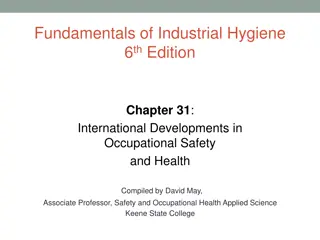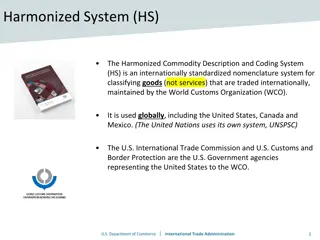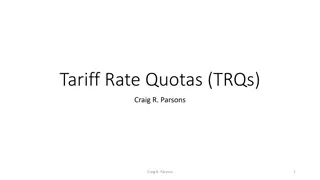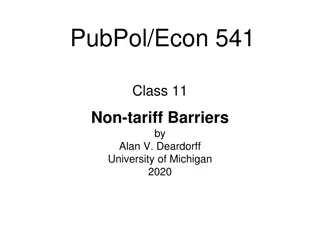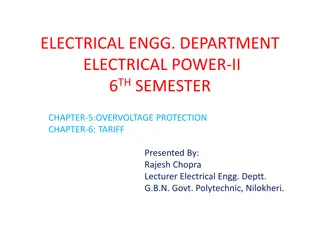Understanding SARS Tariff Determination Process
Explore SARS procedures for tariff determination and legislation provisions. Discover key discussions on customs, compliance, and international conventions.
1 views • 47 slides
Summary of Holistic Review of MPEC Tariff
Provide a summary of the holistic review conducted by SPP Staff on the MPEC Tariff, covering both non-substantive and substantive changes made for review and approval by MDWG. The review includes critical dates, tariff outline, updates from working groups/task forces, and a detailed table of content
0 views • 11 slides
Understanding Rules of Origin and Tariff-Free Trading with the EU
Rules of Origin (RoO) determine the economic nationality of a product, impacting tariffs and restrictions. To trade tariff-free with the EU, compliance with RoO is crucial. Specific rules dictate ingredient sourcing, with certification processes ensuring eligibility for tariff reductions. Certain pr
0 views • 19 slides
Understanding Trade Barriers and Tariff Classification
Explore the concept of trade barriers, including tariff and non-tariff barriers, their objectives, types, and classification. Learn about the benefits of tariff barriers, like discouraging imports and protecting home industries, and the classification of non-tariff barriers such as the quota system
3 views • 28 slides
Advisory Committee Meeting Summary for BSPTCL, BGCL & SLDC
The meeting discussed various topics including tariff petitions, business plans, network status, capacity additions, and cost optimizations for BSPTCL, BGCL, and SLDC in Bihar. Tariff projections, revenue requirements, transmission charges, and revenue surpluses were also analyzed and carried forwar
0 views • 23 slides
Understanding Error Codes in Customs CDS Tariff Training Module 11
This module focuses on interpreting error messages, identifying issues, and correcting errors in Customs CDS Tariff declarations. Learn about error code reference numbers, error descriptions, error locations, and how to fix common issues. Gain insights into cross-validation errors and protective mar
0 views • 13 slides
CDS Training Summary January 2021: Security Marking Presentation
In the CDS Training Summary for January 2021, the focus is on navigating the CDS Volume 3 Tariff, covering declaration categories, data elements, procedure codes, additional information codes, document codes, and more. The training provides a step-by-step guide on using the CDS Tariff, Volume 3, for
0 views • 69 slides
Understanding Tariff Reform Simulations Using UTAS
This presentation introduces tariff reform simulations using UTAS in the context of the car economy example. It covers how tariffs on imported goods impact production costs and effective protection of domestic industries. Key concepts such as output tariff, upstream tariff, and effective protection
0 views • 15 slides
General Rules of Interpretation (GRI) in the Harmonized System
The General Rules of Interpretation (GRI) are essential for classifying products under the Harmonized System. Starting with Rule 1 and progressing to subsequent rules if needed, the process determines classification based on headings, notes, mixtures, and more. Products are classified based on speci
1 views • 5 slides
Understanding Schedule H and Schedule H1 Drugs
Schedule H and Schedule H1 drugs are categories of prescription medications with specific regulations regarding their supply, labeling, and sale. While antibiotics, anti-TB drugs, and habit-forming substances have been categorized under Schedule H1, both schedules require maintaining records of sale
1 views • 14 slides
Understanding Electricity Pricing and Tariff Structure in Pakistan
Electricity pricing involves costs of power plant operations and grid maintenance, impacted by factors like fuel cost, regulations, and consumer demand. Pakistan's tariff structure uses an incremental block tariff system to manage usage, with mechanisms set by regulators for fair pricing and afforda
0 views • 16 slides
Understanding Conditional Duty Exemptions and the Harmonized System
This information delves into the concept of conditional duty exemptions associated with the Common External Tariff (CET) and the Harmonized System (HS). It explains the structure of the Schedule of Rates based on the HS, the application of duty rates in CARICOM, and the lists of items ineligible for
0 views • 16 slides
Comprehensive Guide to the New Customs Declaration Service (CDS)
Navigating the CDS Tariff, UCC alignment, strategic facilitations for UK business, and essential information on the Customs Declaration Service. Learn about data elements, tariff publications, and key changes under CDS for a comprehensive understanding of the trade environment.
0 views • 27 slides
Technical Soundness of EU-SADC EPA Rules of Origin
The implementation and technical soundness of Rules of Origin under the EU-SADC EPA are crucial for the utilization of trade preferences. Compliance with rules of origin is essential for receiving tariff preferences, but drafting these rules accurately is challenging. Recommendations include specify
4 views • 12 slides
Overview of IEEE 802.11-22/487r0 and EN 301.893 Harmonized Standard
This document discusses the March 2022 version of IEEE 802.11-22/487r0, focusing on the EN 301.893 Harmonized Standard. It covers the confidentiality aspects, accessibility of draft standards, and the implications for manufacturers in the European Union market. The latest version, 2.1.47 of the HS,
5 views • 10 slides
Understanding Tariff Systems in Mathematical Literacy - NQF Level 2
Exploring tariff systems in Mathematical Literacy at NQF Level 2, focusing on phone tariffs, calculations, and understanding bundled deals. Learn about different types of tariffs, their costs, and how to analyze and calculate monthly expenses for various phone plans.
0 views • 24 slides
Overview of Conditional Duty Exemptions and Ineligible Commodities under CET
The Harmonized System, administered by the WCO, forms the basis for the Schedule of Rates in the CET. Conditional Duty Exemptions allow goods to be imported duty-free or at reduced rates for specific purposes, subject to approval. Certain commodities are deemed ineligible for duty exemptions, based
0 views • 16 slides
Proposed Changes to Monthly Regional Network Load Calculation and Tariff Language
This proposal outlines changes to the Monthly Regional Network Load (RNL) calculation and tariff language for Avangrid, Eversource, National Grid, VELCO, and Versant. It emphasizes the usage of Monthly RNL in the Open Access Transmission Tariff (OATT) and its impact on Network Customers. The propose
0 views • 7 slides
Optimized Standards for Medical Device Safety and Performance in the EU
This report discusses the importance of harmonized standards in supporting the safety and performance of medical devices in the EU. It highlights the impact of drafting international medical device standards on EU legislation harmonization and emphasizes the role of harmonized standards under the EU
0 views • 8 slides
FERC Order 844 Compliance: Uplift Cost Allocation and Transparency
FERC Order 844, issued in April 2018, mandates reporting on uplift payments and unit commitments, along with revising tariff language for compliance. ISO-NE is proposing new reports and tariff revisions to adhere to the Order, enhancing transparency in operational practices. The Order aims to improv
1 views • 30 slides
New UCAS Tariff for Higher Education Entry Overview
UCAS has introduced a new Tariff for higher education entry starting from September 2017. This toolkit is designed to assist teachers and advisers in understanding the changes, timeline, points system, university examples, myth debunking, and available resources. The aim is to prepare educators and
0 views • 32 slides
CBP Rulings Online: Explore Classification Decisions for Imports
Importers can access past classification rulings by CBP in the Harmonized Tariff Schedule (HTS) to aid in classifying new and innovative products. Reviewing CBP decisions is valuable, especially for complex items like submersible ROVs used in the oil and gas industry. By checking historical rulings,
1 views • 4 slides
ASEAN Harmonized MRLs and Minor Use Overview
Explore the establishment of ASEAN harmonized Maximum Residue Limits (MRLs) and the current situation in agricultural cooperation, covering topics such as risk assessment, collaboration structures, and the way forward. Gain insights into the importance of MRL adoption, Codex regulations, and pestici
0 views • 11 slides
Harmonized Cold Treatment Scheme for Fruit Fly in Fresh Fruits Expert Consultation
The 2013 IPPC Expert Consultation in Buenos Aires, Argentina discussed the need for a harmonized cold treatment scheme for fruit flies in fresh fruits. The goal was to control regulated pests in international trade and suggest experiments for harmonizing cold treatment protocols. Prohibited articles
0 views • 13 slides
Overview of LAO's Tariff Consultations for Family and Child Protection Modernization Program
LAO is seeking input on tariff reform as part of its modernization program to enhance Ontario's legal aid system. The focus is on immediate, cost-neutral updates and future potential increases. Feedback will help simplify billing rules, improve online services, and streamline access to information,
0 views • 15 slides
Understanding LJMU Penalty Tariff for Academic Misconduct
The LJMU Penalty Tariff, implemented from September 2011, ensures fair and consistent penalties for academic misconduct at LJMU. Points are allocated based on criteria, with penalties ranging from allowing new work submissions to expulsion. AMP outcomes are recorded using Service Indicators that rem
0 views • 17 slides
Preparing Energy Storage Systems for Public Safety Power Shutoff Events
Modernizing the NEM tariff to allow pre-PSPS charging involves utilities proposing modifications to allow energy storage systems to temporarily import energy from the grid upon advanced notification of a PSPS event. This process includes coordination with developers/aggregators and consultation with
0 views • 7 slides
Understanding Rules of Origin in EU-UK Trade
Rules of Origin (RoO) are essential in determining the economic nationality of products for tariff classification in EU-UK trade. Compliance with RoO is necessary for accessing preferential tariff rates under free trade agreements. This guidance outlines the principles, conditions, and requirements
0 views • 19 slides
Guidelines for Harmonized System Classification of Goods
Understand the step-by-step process of classifying goods under the Harmonized System, including referencing section notes and chapter notes, resolving ambiguities in word meanings, identifying essential characteristics of unfinished goods, choosing specific headings over general ones, and classifyin
0 views • 41 slides
Development of Harmonized North American Life Jacket Standards
The development of harmonized North American life jacket standards led by Brandi Baldwin in the Lifesaving & Fire Safety Division at the Office of Design & Engineering Standards is a crucial regulatory process. It involves regulatory progress, standards development, consensus processes, and ongoing
0 views • 16 slides
Stakeholders Presentation on 2022/23 Tariff Structure
Consultation with stakeholders on the proposed Water Resource Management Charges for the 2022/23 financial year by the Breede-Gouritz Catchment Management Agency. The presentation covers operational capacity, strategic priorities, tariff process, and budget planning processes aligned with National T
0 views • 15 slides
Understanding Hazard Communication and the Global Harmonized System
This content discusses the changes introduced by the Global Harmonized System in Hazard Communication Standards (HCS). It highlights the impact on classifications, labels, safety data sheets, and information and training requirements. The GHS aims to enhance workplace safety by providing a standardi
0 views • 37 slides
Global Harmonized System (GHS) in Hazard Communication and Safety
The Global Harmonized System (GHS) establishes a uniform classification and labeling of chemicals to ensure effective communication of hazards globally. Developed to improve chemical management and safety, GHS aims to provide consistent protection and reduce regulatory burdens. Adopted international
0 views • 60 slides
Understanding GHS: The Globally Harmonized System of Classification and Labeling of Chemicals
The Globally Harmonized System (GHS) is a standardized approach to classifying and labeling chemicals, offering workers the right to understand hazards. It enhances cross-border communication, reduces confusion, and ensures consistent information. Major changes in GHS labels and Safety Data Sheets i
0 views • 17 slides
Importance of Hazard Communication Training for Workplace Safety
Hazard communication training is essential for creating a safe work environment by helping individuals recognize and manage hazardous materials effectively. Understanding the Globally Harmonized System (GHS) and following hazard communication laws can improve workplace safety, protect human health,
0 views • 36 slides
Global Harmonized System of Classification and Labeling of Chemicals (GHS) Overview
The Global Harmonized System of Classification and Labeling of Chemicals (GHS) was developed to address the inconsistencies in hazard information for chemicals globally due to significant trade. The history, mandate, and provisions of GHS, along with additional domestic harmonization efforts, are di
0 views • 29 slides
Understanding the Harmonized System (HS) for International Trade
The Harmonized System (HS) is an internationally standardized nomenclature system for classifying goods traded internationally, managed by the World Customs Organization (WCO). It organizes goods into categories down to the 6-digit level, providing a common set of descriptive categories for global t
0 views • 10 slides
Understanding Tariff Rate Quotas (TRQs) in International Trade
Tariff Rate Quotas (TRQs) are commonly used in global trade, particularly in agricultural imports. They involve lower tariff rates on imports up to a specified quantity per year, with higher rates applied to any excess imports. This system aims to regulate trade and protect domestic producers. TRQ l
0 views • 10 slides
Understanding Non-Tariff Barriers in International Trade
Explore the types of Non-Tariff Barriers (NTBs) and Non-Tariff Measures (NTMs) such as quotas, Tariff-Rate Quotas (TRQs), Voluntary Export Restraints (VERs), and more. Learn about Administered Protection, Safeguards tariffs, Anti-dumping duties, Countervailing duties, and their implications on trade
0 views • 57 slides
Electrical Engineering: Overvoltage Protection and Tariff Concepts
In the field of electrical engineering, it is crucial to understand overvoltage protection mechanisms to safeguard against electrical surges caused by internal and external factors like switching surges and lightning. Various protection methods such as ground wires, earthing screens, and lightning a
0 views • 12 slides
